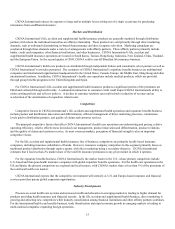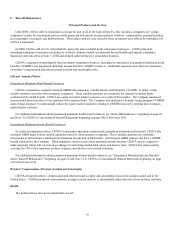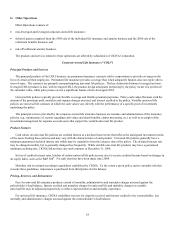Cigna 2008 Annual Report Download - page 28
Download and view the complete annual report
Please find page 28 of the 2008 Cigna annual report below. You can navigate through the pages in the report by either clicking on the pages listed below, or by using the keyword search tool below to find specific information within the annual report.8
family size, industry, renewal date, and other cost-predictive factors. In some states, premium rates must be approved by the state
insurance departments, and state laws may restrict or limit the use of rating methods.
Premiums established for retrospectively experience-rated business may be adjusted for the actual claim and, in some cases,
administrative cost experience of the account through an experience settlement process subsequent to the policy period. To the extent
that the cost experience is favorable in relation to the prospectively determined premium rates, a portion of the initial premiums may
be credited to the policyholder as an experience refund. If claim experience is adverse in relation to the initial premiums, CIGNA
HealthCare may recover the resulting experience deficit, according to contractual provisions, through future premiums and experience
settlements, provided the policy remains in force.
CIGNA HealthCare contracts on an ASO basis with customers who fund their own claims. CIGNA HealthCare charges these
customers administrative fees based on the expected cost of administering their self-funded programs. In some cases, CIGNA
HealthCare provides performance guarantees associated with meeting certain service related and other performance standards. If
these standards are not met, CIGNA HealthCare may be financially at risk up to a stated percentage of the contracted fee or a stated
dollar amount. CIGNA HealthCare establishes liabilities for estimated payouts associated with these guarantees.
In addition to paying current benefits and expenses under HMO and health insurance policies, CIGNA HealthCare establishes
reserves for amounts estimated to settle reported claims not yet paid, as well as claims incurred, but not yet reported. Also, liabilities
are established for estimated experience refunds based on the results of retrospectively experience-rated policies and applicable
contract terms.
As of December 31, 2008, approximately $1.0 billion, or 65% of the reserves of CIGNA HealthCare’s operations comprise
liabilities that are likely to be paid within one year, primarily for medical and dental claims, as well as certain group disability and life
insurance claims. Of the reserve amount expected to be paid within one year, $202 million relates to amounts recoverable from
certain ASO customers and from minimum premium policyholders, and is offset by a receivable. The remaining reserves related
primarily to contracts that are short term in nature, but have long term payouts and include liabilities for group long-term disability
insurance benefits and group life insurance benefits for disabled and retired individuals, benefits paid in the form of both life and non-
life contingent annuities to survivors and contractholder deposit funds.
CIGNA HealthCare credits interest on experience refund balances to retrospectively experience-rated policyholders through rates
that are set by CIGNA HealthCare taking investment performance and market rates into consideration. Generally, for
interest-crediting rates set at CIGNA HealthCare’s discretion, higher rates are credited to funds with longer terms reflecting the fact
that higher yields are generally available on investments with longer maturities. For 2008, the rates of interest credited ranged from
2.75% to 4.00%, with a weighted average rate of 3.15%.
The profitability of CIGNA HealthCare’s fully insured health care products depends on the adequacy of premiums charged
relative to claims and expenses. For medical and dental products, profitability reflects the accuracy of cost projections for health care
(unit costs and utilization), the adequacy of fees charged for administration and risk assumption and effective medical cost and
utilization management.
CIGNA HealthCare reduces its exposure to large catastrophic losses under group life, disability and accidental death contracts by
purchasing reinsurance from unaffiliated reinsurers.
Markets and Distribution
CIGNA HealthCare targets the following markets for its products:
• national accounts, which are multi-site employers generally with more than 5,000 employees;
• regional accounts, which are generally defined as multi-site employers with more than 250 but fewer than 5,000 employees, and
single-site employers with more than 250 employees;
• “Select,” which generally includes employers with 51- 250 employees;
• small business, which generally includes employers with 2-50 employees;
























